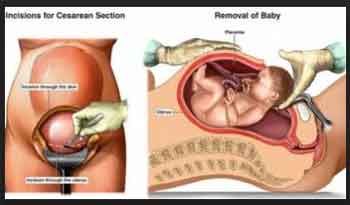- Home
- Editorial
- News
- Practice Guidelines
- Anesthesiology Guidelines
- Cancer Guidelines
- Cardiac Sciences Guidelines
- Critical Care Guidelines
- Dentistry Guidelines
- Dermatology Guidelines
- Diabetes and Endo Guidelines
- Diagnostics Guidelines
- ENT Guidelines
- Featured Practice Guidelines
- Gastroenterology Guidelines
- Geriatrics Guidelines
- Medicine Guidelines
- Nephrology Guidelines
- Neurosciences Guidelines
- Obs and Gynae Guidelines
- Ophthalmology Guidelines
- Orthopaedics Guidelines
- Paediatrics Guidelines
- Psychiatry Guidelines
- Pulmonology Guidelines
- Radiology Guidelines
- Surgery Guidelines
- Urology Guidelines
Length of incision may affect pain after cesarean delivery

Both short and long surgical incisions for cesarean births are associated with increased pain after delivery, suggests a study being presented at the ANESTHESIOLOGY 2017 annual meeting. Based on the findings, the authors recommend an optimal range for cesarean incision length to be between 12 and 17 centimeters (about 4.5 - 6.5 inches), and advise that neither shorter nor longer incisions be performed when possible.
"To our knowledge, this 'Goldilocks effect' of surgical incision length on pain outcomes has not been previously reported, and merits further investigation to unravel the effects of short-term tissue stretch and increased tissue trauma on acute and chronic post-cesarean pain," said lead researcher Ruth Landau, M.D., associate director of obstetric anesthesia and director of the Center for Precision Medicine in Anesthesiology at Columbia University Medical Center in New York. "We were surprised to find tremendous variability in surgical incision length. While the median length was 15 centimeters, the range was from 9 to 23 centimeters, which may in part be due to the surgeons' practice and patients' body characteristics."
The study included 690 women undergoing elective cesarean delivery, of which 37 percent had a repeat cesarean, who were evaluated pre-operatively and followed for up to 12 months. Both the shorter and longer extremes of surgical incision length were associated with increased pain. Women with shorter incisions (less than 12 cm or about 4.5 inches) were more likely to report higher pain scores immediately after delivery, which, according to the authors, likely indicates intense tissue stretching during delivery. Women with longer incisions (more than 17 cm or about 6.5 inches) were also more likely to report higher pain scores, including wound hyperalgesia, or an increased sensitivity to pain around the surgical incision.
Consistent with the researchers' previous work, chronic pain after cesarean delivery was extremely rare, with less than 3 percent of women reporting chronic pain one year after their cesarean delivery. Among those who underwent a repeat cesarean, chronic pain was reported by 12 of them, compared to seven of the women who had a cesarean for the first time (4.7 percent vs 1.6 percent). Overall at one year, surgical-related pain symptoms, mostly described as "tender pain," were reported by 4.7 percent of women, and neuropathic symptoms such as itching, tingling or numbing were reported by 19 percent.
The multicenter study evaluated numerous factors including the influence of ethnicity, body mass index (BMI), psychological parameters and previous scar characteristics for women with a prior cesarean delivery as well as current wound characteristics. The study found that while women with a high BMI were more likely to have a longer surgical incision, not all women with longer surgical incisions were obese.
"Cesarean section is a unique surgical model, because obstetricians may perform the exact same surgical procedure repeatedly on the same woman. Therefore, studies that identify the ideal length of surgical incision in cesareans, taking into account women's body build and previous scar, if present, are important," Dr. Landau said "Furthermore, studies that evaluate whether persistent neuropathic pain symptoms from a previous cesarean are associated with a worse pain experience in a following cesarean delivery may provide insights about mechanisms that prevent normal healing and the transition from acute to chronic pain."

Disclaimer: This site is primarily intended for healthcare professionals. Any content/information on this website does not replace the advice of medical and/or health professionals and should not be construed as medical/diagnostic advice/endorsement or prescription. Use of this site is subject to our terms of use, privacy policy, advertisement policy. © 2020 Minerva Medical Treatment Pvt Ltd